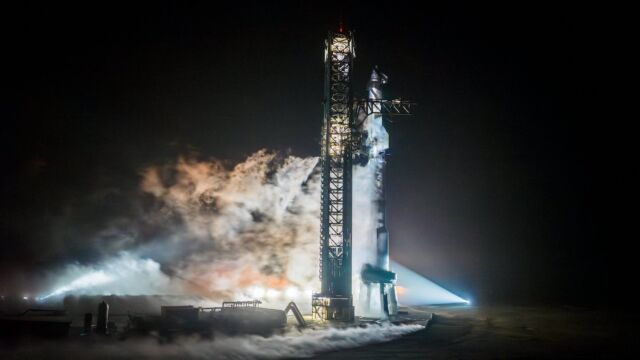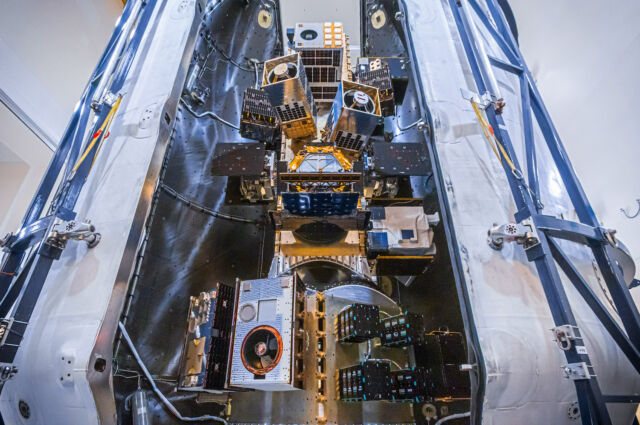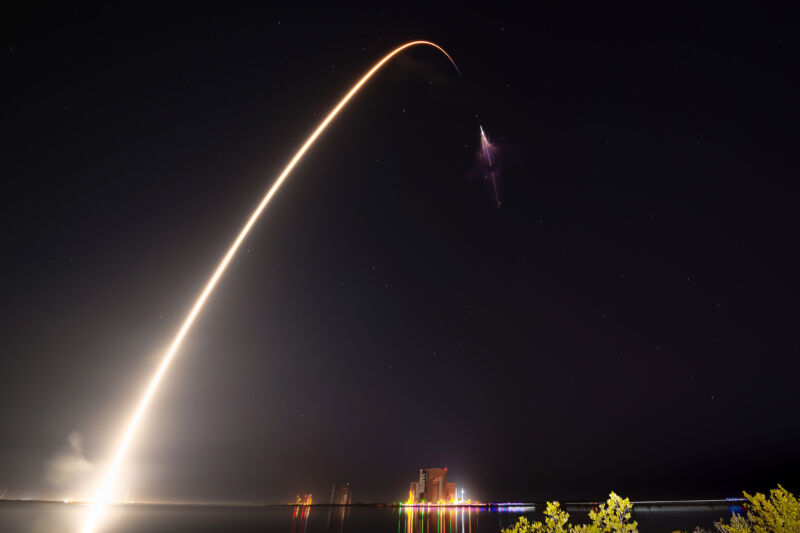Between Sunday night and Monday night, SpaceX teams in Texas, Florida, and California supervised three Falcon 9 rocket launches and completed a full dress rehearsal ahead of the next flight of the company’s giant Starship launch vehicle.
This was a remarkable sequence of events, even for SpaceX, which has launched a mission at an average rate of once every three days since the start of the year. We’ve reported on this before, but it’s worth reinforcing that no launch provider, commercial or government, has ever operated at this cadence.
SpaceX has previously had rockets on all four of its active launch pads. But what SpaceX accomplished over a 24-hour period was noteworthy. Engineers inside at least four control centers were actively overseeing spacecraft and rocket operations simultaneously.
The sprawl of SpaceX
On Sunday night at the Starbase facility in South Texas, teams loaded more than 10 million pounds of methane and liquid oxygen propellants into the nearly 400-foot-tall (121-meter) Starship rocket slated to lift off as soon as this month on the third full-scale test flight of SpaceX’s next-generation launcher.
This was likely the final major test before SpaceX launches the third Starship test flight. The countdown rehearsal of the fully stacked rocket ended as planned at T-minus 10 seconds, just before the booster’s Raptor engines were ignited; SpaceX then drained the vehicle of propellant. SpaceX previously test-fired the Super Heavy booster and Starship upper stage separately.
The schedule for the next Starship launch hinges on approval from the Federal Aviation Administration, which is reviewing SpaceX’s actions to correct the malfunctions that occurred on the second Starship test flight in November. Last week, the FAA announced it closed its investigation into the second Starship test flight, which was largely successful in demonstrating significant progress on SpaceX’s privately funded rocket program. But the test flight ended with explosions of the Super Heavy booster and Starship upper stage, prompting an FAA investigation.
On the next Starship flight, SpaceX wants to perform some early-stage testing of the in-space refueling technology it will need for later Starship flights, such as missions to the Moon for NASA.

At the same time SpaceX’s team in Texas managed the Starship countdown rehearsal, another group of engineers and technicians on Florida’s Space Coast stepped through a Falcon 9 launch countdown Sunday night. Three NASA astronauts and one Russian cosmonaut strapped into their seats on SpaceX’s Crew Dragon Endeavour spacecraft on top of the Falcon 9 rocket, then waited for liftoff from Launch Complex 39A at NASA’s Kennedy Space Center at 10:53 pm EST Sunday (03:53 UTC Monday).
The Falcon 9 launch of NASA’s Crew-8 mission Sunday night was the first of three Falcon 9 launches over the next 20 hours. Next in line was a launch at 5:05 pm EST (2205 UTC) Monday from Vandenberg Space Force Base in California with 53 small payloads on SpaceX’s 10th Transporter rideshare mission. The customer payloads on this Falcon 9 launch included MethaneSAT, an $88 million satellite funded primarily by philanthropic donations to monitor methane greenhouse gas missions around the world.
Then, less than two hours later, at 6:56 pm EST (2356 UTC), a Falcon 9 rocket took off from SpaceX’s most active launch pad at Cape Canaveral Space Force Station in Florida. This mission delivered 23 more Starlink broadband satellites into orbit for SpaceX’s commercial Internet network. At 1 hour and 51 minutes, this was the shortest time separation to date between two SpaceX launches.
All three Falcon 9 launches ended with landings of the rockets’ first stage boosters.

While controllers at Starbase, Cape Canaveral, and Vandenberg looked after these three Falcon 9 launches, SpaceX engineers at the company’s headquarters near Los Angeles tracked the performance and progress of the Crew Dragon Endeavour spacecraft on its way to the International Space Station, where it docked early Tuesday. Next week, another SpaceX capsule, Crew Dragon Endurance, will depart the station to bring a different four-person crew back to Earth.
SpaceX, which now has more than 13,000 employees, pulled off a similar rapid-fire launch cadence in mid-February with three Falcon 9 launches in approximately 23 hours, but this time included the additional complexity of operating a Dragon crew capsule en route to the ISS, plus the Starship countdown in Texas. While all this was going on, a handful of ground controllers also monitored the health of the Dragon spacecraft currently docked at the space station.
Constraint to launch
SpaceX has modified its primary Cape Canaveral launch pad—Space Launch Complex 40 (SLC-40)—over the last few months to accommodate Falcon 9 launches with Dragon crew and cargo capsules, a capability currently exclusive to Launch Complex 39A (LC-39A) a few miles to the north at Kennedy Space Center. While LC-39A is not used as often as SLC-40, it has been the only launch pad outfitted to launch Dragon crew and cargo missions, and the Falcon Heavy rocket.
With a new servicing tower and arm to allow access to the Dragon spacecraft on the launch pad, SLC-40 will be ready for the launch of SpaceX’s next Dragon resupply mission to the space station later this month, NASA and SpaceX officials said last week. If needed, it could be used for SpaceX’s next commercial crew mission this summer.
The availability of SLC-40 for crew and cargo missions helps offload demand from LC-39A. For example, if a critical military or NASA planetary science payload needs to launch on a Falcon Heavy rocket at the same time as a Dragon crew mission, SpaceX could shift the crew launch over to SLC-40. The crew launch capability at SLC-40 also helps alleviate NASA’s concerns about SpaceX’s plan to launch Starship rockets from LC-39A.
Before its launch Sunday night, the launch date for NASA’s Crew-8 mission was delayed about a week because of a scheduling conflict at LC-39A. Intuitive Machines’ Odysseus lunar lander, which NASA had under contract, took priority in the schedule because it at a narrow launch window of just a few days in mid-February in order to reach the Moon. The Odysseus lander had to launch from LC-39A because SpaceX upgraded the pad to load cryogenic propellants into the payload just before liftoff.
“Could you imagine if I had walked up to you five years ago and said our constraint to launch is launch pad availability?” said Matthew Dominick, the NASA commander of the Crew-8 mission. “You would have thought I was crazy, but we’re at a cool spot in spaceflight right now. We’ve got rockets competing for launch pads, so you’re not waiting on payloads. You’re not waiting on rockets. You’re waiting on launch pads now.”
All told, SpaceX continues to expand its launch capacity for Falcon 9 and Starship. The company aims to launch its Falcon rocket fleet more than 140 times this year, up from 96 Falcon 9 and Falcon Heavy flights in 2023. SpaceX wants to launch “at least” nine Starship test flights this year. You can probably count on even higher numbers for both of SpaceX’s rocket families in 2025.
SpaceX plans to construct a second Starship launch tower at Starbase in Texas. It already has a partially built Starship launch complex at Kennedy Space Center, and preliminary plans exist to install another Starship launch pad at Cape Canaveral Space Force Station.
Days like Sunday and Monday will become more common if SpaceX achieves its goals with the fully reusable Starship rocket.
Elon Musk, SpaceX’s founder and CEO, has said one measure of success for SpaceX is to make rocket launches boring. The regularity of the Falcon 9 launch rate has succeeded in eroding the news value of many of SpaceX’s missions, but thousands of people, at least space enthusiasts, still log in to watch every launch.
It’s difficult to gauge how many people are watching SpaceX’s official launch livestreams after the company shifted away from YouTube and started streaming launches only on X, the social media platform also owned by Musk. Initially, at least, this appeared to have the effect of suppressing the number of viewers for SpaceX’s live productions. However, launch viewership on third-party streamers, such as NASASpaceflight and Spaceflight Now, has only increased as space missions fly more often.
Launches remain exciting, but that’s not such a bad thing.
